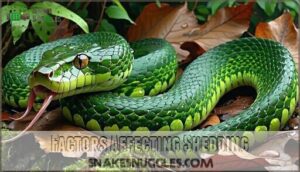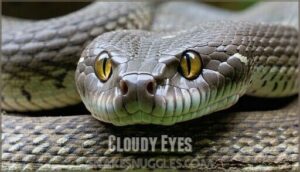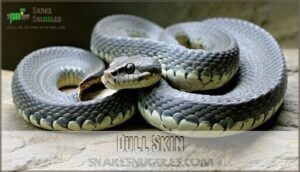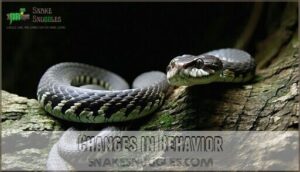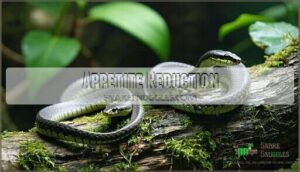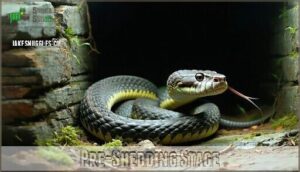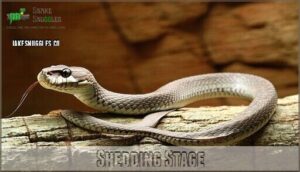This site is supported by our readers. We may earn a commission, at no cost to you, if you purchase through links.
 Your snake’s healthy snake shedding frequency depends on its age and size.
Your snake’s healthy snake shedding frequency depends on its age and size.
Young snakes shed every 4-8 weeks as they grow rapidly, while adults shed every 2-4 months.
You’ll notice cloudy eyes, dull skin, and reduced appetite before shedding begins.
Species, diet, and environmental conditions like humidity and temperature also affect timing.
Ball pythons might shed less frequently than corn snakes, for example.
A proper shedding cycle indicates good health and growth.
If your snake’s shedding becomes irregular or incomplete, it’s worth examining their habitat conditions and overall care routine to verify everything’s on track.
Table Of Contents
- Key Takeaways
- Snake Shedding Basics
- Factors Affecting Shedding
- Signs of Healthy Shedding
- Shedding Process Stages
- Creating Ideal Shedding Environment
- Maintaining Healthy Shedding Frequency
- Frequently Asked Questions (FAQs)
- How often do snakes shed their skin?
- Do snakes shed a lot?
- Do obese snakes shed more often?
- Why do snakes shed less in winter?
- Is it normal for snakes to stop eating before a shed?
- What happens immediately after a snake sheds?
- How often should a snake shed?
- Does snake shedding mean it’s healthy?
- Why is my snake shedding so frequently?
- Do snakes shed skin when stressed?
- Conclusion
Key Takeaways
- Your snake’s shedding frequency changes with age – young snakes shed every 4-8 weeks, while adults shed every 2-4 months, so do not expect the same schedule throughout their life
- Watch for clear warning signs before shedding – you will notice cloudy eyes, dull skin, and reduced appetite about 1-2 weeks before your snake actually sheds
- Maintain proper humidity and temperature – keep humidity between 50-70% and temperatures at 75-92°F to prevent incomplete sheds and complications
- Do not handle your snake during shedding – avoid unnecessary handling when you see pre-shed signs, as this stresses them and can disrupt the natural process
Snake Shedding Basics
Understanding your snake’s shedding patterns helps you provide better care and spot potential health issues early.
Snakes naturally shed their entire outer skin layer through a process called ecdysis, which occurs regularly throughout their lives as they grow and maintain healthy skin.
Ecdysis is nature’s way of giving snakes a fresh start as they outgrow their old skin.
What is Ecdysis
Ecdysis is the natural biological process where snakes shed their entire outer skin layer.
Think of it like taking off a tight sweater that no longer fits.
Here’s what happens during this remarkable transformation:
- Old skin becomes restrictive as your snake grows
- New skin layer forms underneath the existing one
- Specialized enzymes separate old from new skin
- Snake rubs against surfaces to start peeling
- Complete skin comes off in one piece
This shedding cycle allows for proper snake growth and skin regeneration, making biological renewal possible for healthy development.
Importance of Shedding
Throughout your snake’s life, healthy shedding provides essential shedding benefits that go far beyond simple skin regeneration.
This natural process supports proper growth patterns while serving as reliable health indicators for attentive owners.
Snake shedding removes damaged cells, eliminates harmful parasites, and creates space for continued development.
The reptile shedding process gives your pet a fresh start with vibrant, protective skin.
Understanding the snake skin shedding process is vital for providing superior care and identifying potential health issues in your snake.
Frequency of Shedding
Young snakes shed monthly due to rapid growth rates, while adults shed every 1-3 months.
Shedding frequency depends on age, species, and environmental impact.
Ideal humidity levels (50-70%) and proper temperatures support healthy shedding cycles.
Ball pythons demonstrate typical shedding patterns: juveniles shed every 4-6 weeks, adults every 6-8 weeks.
Monitor your snake’s individual snake shedding frequency for signs of proper skin regeneration.
Factors Affecting Shedding
Your snake’s shedding schedule isn’t set in stone—it changes based on several key factors that you can actually influence.
Understanding what affects this natural process helps you provide better care and know what’s normal for your specific snake, which is crucial for complete concepts of snake health.
Age and Size
Age substantially impacts Growth Patterns and shedding frequency in your snake.
Size Factors determine how often your pet will shed its skin throughout its life.
Age Effects on Shedding Cycles:
- Hatchlings – Shed every 2-4 weeks due to rapid Youth Development
- Juveniles – Shed every 4-8 weeks as growth slows down
- Adults – Shed every 2-6 months with matured body size
- Seniors (10+ years) – May shed only twice yearly
- First-year snakes – Can shed up to 15 times annually
Understanding age-dependent shedding helps you monitor your snake’s health and anticipate shedding duration needs.
Species Variations
Different snake species shed at varying rates based on their genetics and natural biology.
Ball pythons shed every 4-6 weeks as juveniles, while corn snakes follow similar patterns averaging 8-12 annual sheds.
Boa constrictors typically shed every 2-4 months once mature, and these species comparison show how snake genetics influence individual shedding patterns and skin health requirements.
Diet and Nutrition
Your snake’s diet directly impacts how often it sheds.
A nutrient-rich diet with proper nutrition supports regular shedding cycles, while poor food quality delays the process.
Feeding schedules matter too—well-fed juveniles shed more frequently than underfed adults.
Water intake helps skin separate during ecdysis.
Quality protein sources and nutrient balance keep your snake’s skin healthy and shedding on schedule, with proper nutrition supporting overall health, and a nutrient-rich diet being essential for regular shedding cycles.
Environmental Conditions
Temperature control and humidity levels create the foundation for successful snake shedding.
Your pet’s environment directly impacts when and how well they’ll shed their skin.
Key Environmental Factors:
- Temperature gradient of 75-92°F supports healthy skin regeneration
- Humidity levels between 50-70% prevent incomplete sheds
- Water availability through bowls or moist hide boxes
- Air quality with proper ventilation prevents bacterial growth
- Lighting effects that maintain natural day-night cycles
Proper environmental conditions make shedding smoother for your snake.
Signs of Healthy Shedding
You’ll notice several clear signs when your snake is preparing to shed its skin in a healthy cycle.
These indicators help you track your pet’s natural rhythm and guarantee they’re getting proper care during this vulnerable time.
Cloudy Eyes
One of the most reliable shedding signs you’ll notice is when your snake’s eyes turn cloudy or bluish-grey.
Cloudy eyes signal your snake is ready to shed – nature’s perfect timing system.
This eye clouding happens in over 90% of snakes during the blue** phase, lasting 3-7 days.
The cloudiness occurs from lymph fluid building up between old and new eye cap layers, causing vision impairment that makes your snake more defensive and reclusive.
Dull Skin
Beyond cloudy eyes, your snake’s skin will lose its usual shine and become noticeably dull.
This color change signals healthy skin regeneration as the old layer prepares to separate. The lackluster appearance affects all scales, creating a faded look that’s completely normal.
This dullness indicates proper shedding signs and scale care processes working correctly. Understanding the shedding process signs is essential for identifying healthy shedding in snakes.
Changes in Behavior
Alongside dull skin coloration, you’ll notice distinct behavioral signs that signal impending shedding.
Your snake becomes more reclusive, seeking dark hiding spots due to impaired vision from cloudy eyes. This hiding behavior is completely normal – they’re simply protecting themselves during vulnerability.
You might also observe increased restlessness as they rub against rough surfaces, preparing to remove old skin. These preshed signs indicate healthy shedding preparation.
Appetite Reduction
Food intake patterns shift dramatically during pre-shedding periods, with decreased appetite being one of the most reliable indicators you’ll observe.
Your snake’s eating habits will change as hunger cycles become disrupted, often resulting in complete appetite loss for several days or weeks.
This feeding pattern change isn’t concerning—it’s natural preparation for ecdysis that prevents potential shedding problems or stuck shed complications.
Shedding Process Stages
Understanding your snake’s shedding stages helps you provide better care during this vulnerable time. The process unfolds in three distinct phases, each with unique characteristics and care requirements.
Pre-Shedding Stage
During the pre-shed phase, your snake’s skin becomes dull and loses its vibrant colors while eye cloudiness develops.
Behavioral changes include increased hiding frequency and appetite loss as your snake seeks seclusion.
This preshedding stage typically lasts one to two weeks before the actual shedding stage begins, marking a critical period in the snake shedding process.
Understanding the snake’s shedding cycle stages is essential for providing proper care during this time.
Shedding Stage
Once your snake’s eyes clear, the actual shedding stage begins.
Most snakes complete this process within 1-6 hours, rubbing against rough surfaces to peel away old skin in one continuous piece.
You’ll notice increased activity as they work to remove their outgrown skin.
The skin regeneration process reveals vibrant, healthy scales underneath when successful, and this is a sign of a successful shedding process is not correct so: The skin regeneration process reveals vibrant, healthy scales underneath when successful.
Post-Shedding Stage
After your snake sheds, expect a vibrant transformation.
The new skin care period reveals enhanced colors and clearer eyes, marking successful skin regeneration.
Your snake’s eye clearance signals healthy shedding recovery.
Monitor for incomplete shedding around the tail or eyes during this postshedding phase.
Post shed health improves as your snake resumes normal behavior, showcasing nature’s remarkable snake skin regeneration process, with a vibrant transformation.
Creating Ideal Shedding Environment
Creating the right environment makes all the difference when your snake prepares to shed.
You’ll want to focus on three key areas: maintaining proper humidity and temperature, setting up the right cage size with helpful furnishings, and knowing how to handle your snake during this sensitive time.
This includes complete concepts such as setting up the right environment to ensure a smooth shedding process.
Humidity and Temperature
During shedding cycles, maintaining humidity levels between 50-70% proves essential for proper skin separation.
Temperature gradients of 75-90°F support enzymatic processes that facilitate healthy ecdysis.
Environmental balance requires consistent moisture control and thermal cycles.
Digital hygrometers help monitor these conditions accurately, and accurate humidity readings from a digital hygrometer tool are vital for maintaining ideal environmental conditions.
Poor humidity and temperature control causes over 50% of shedding problems in captive snakes.
Cage Size and Furnishings
Beyond proper humidity and temperature, your snake enclosure needs adequate space and smart furnishings.
Cage Depth should allow full stretching while Snake Hides provide security during vulnerable shedding periods.
Include rough Branch Texture surfaces for rubbing assistance, and choose moisture-retaining Substrate Choice like cypress mulch.
Add Humidity Boxes near the basking zone for extra moisture access when needed.
The snake’s overall health can be supported by understanding snake hide options to create a suitable environment.
Handling Snakes During Shedding
When your snake enters the snake shedding cycle, resist the urge to handle them unnecessarily.
Gentle handling during this vulnerable period prevents stress and potential skin damage. Focus on snake shedding support through environmental adjustments rather than direct intervention.
Essential snake shedding care practices include:
- Humidity control – Maintain 60-70% humidity and provide snake soaking opportunities in shallow, lukewarm water
- Minimize disturbance – Avoid handling unless absolutely necessary to prevent interrupting the natural snake shedding environment
- Monitor for snake shedding issues – Watch for incomplete sheds that may require gentle shedding aids or skin lubrication assistance
Maintaining Healthy Shedding Frequency
Maintaining healthy shedding frequency requires consistent care and attention to your snake’s environment and health.
Regular monitoring helps you catch potential problems early and guarantees your snake sheds successfully throughout its life, which is crucial for consistent care and overall health.
Regular Veterinary Check-Ups
Routine vet visits help your snake’s shedding cycle stay healthy.
A qualified reptile veterinarian can spot early warning signs of medical issues that disrupt normal shedding patterns.
Regular veterinary checkups help identify problems like parasites, dehydration, or nutritional deficiencies before they affect your pet’s skin health.
Schedule annual exams for superior veterinary care.
Understanding snake shedding problems is vital for maintaining a healthy pet, and recognizing early warning signs is crucial.
Proper Care and Nutrition
Quality nutrition directly impacts your snake’s ability to shed properly.
A well-balanced diet rich in appropriate prey items provides the proteins and nutrients needed for healthy skin regeneration.
Make certain fresh water is always available, as proper hydration supports the shedding process.
Monitor your snake’s body condition regularly – overweight or underweight snakes often experience shedding complications that require dietary adjustments.
Providing the right snake food supplements is vital for maintaining healthy health, which involves understanding proper snake nutrition needs, and this includes ensuring proper hydration, a well-balanced diet, and being aware of shedding complications.
Monitoring for Shedding Problems
Your snake’s skin tells a story about its health. Watch for warning signs that signal shedding troubles requiring immediate attention.
- Retained shed skin clinging to tail tips or eye caps after 48 hours
- Shedding delays beyond normal cycles indicate health checks are needed
- Incomplete shed patterns suggesting dysecdysis or environmental issues
- Snake stress behaviors like excessive rubbing or prolonged hiding during shedding difficulties
Providing Optimal Environment
Creating the right environment makes all the difference for successful shedding.
Maintain humidity levels between 50-70% with a dedicated humidity box filled with damp substrate. Establish temperature gradients from 75-92°F across the enclosure.
Provide shedding boxes with rough surfaces and humid hides for shedding assistance. Choose moisture-retaining substrates like cypress mulch.
Add environmental enrichment through branches and hiding spots to support natural shedding behaviors, which can be enhanced by environmental enrichment.
Frequently Asked Questions (FAQs)
How often do snakes shed their skin?
Like clockwork, snakes shed their skin regularly throughout their lives.
You’ll see young snakes shed every few weeks, while adults typically shed two to four times yearly, depending on species, health, and environmental conditions, which can be influenced by several factors including health.
Do snakes shed a lot?
Most snakes don’t shed excessively—they’ll shed their skin 4-12 times yearly, with young ones shedding monthly and adults every few months, depending on growth rate and environmental conditions.
Do obese snakes shed more often?
Obesity doesn’t directly increase shedding frequency in snakes.
However, overweight snakes may struggle with incomplete sheds due to poor circulation, reduced mobility, and difficulty rubbing against surfaces to remove old skin properly, which can lead to issues with incomplete sheds.
Why do snakes shed less in winter?
Winter’s cooler temperatures slow your snake’s metabolism, reducing their growth rate and cellular activity.
Since they’re growing less and regenerating skin cells slower, they don’t outgrow their current skin as quickly, naturally extending the time between sheds.
This process is a result of the slower metabolism, which affects the snake’s overall growth rate.
Is it normal for snakes to stop eating before a shed?
Yes, it’s completely normal for snakes to stop eating before shedding. Decreased appetite is a common pre-shed behavior that helps them focus energy on the shedding process without digestive complications.
What happens immediately after a snake sheds?
Like a snake version of a wardrobe change, your pet emerges with brilliant new skin that’s more vibrant than before. You’ll notice increased appetite and normal activity returning within days.
How often should a snake shed?
Your snake should shed every 2-12 weeks, depending on age and species.
Young snakes shed monthly, while adults shed every 1-3 months.
Healthy shedding frequency depends on proper humidity, temperature, nutrition, and overall health.
Does snake shedding mean it’s healthy?
A healthy snake that’s shedding is like a growing child outgrowing clothes—it’s natural.
Regular shedding every 4-12 weeks typically signals good health, proper nutrition, and appropriate environmental conditions in your snake’s habitat, which can be seen as a sign of proper nutrition.
Why is my snake shedding so frequently?
Frequent shedding usually indicates your snake’s growing rapidly, especially if it’s young.
However, stress, poor humidity, illness, or parasites can also trigger extra shedding cycles, so monitor other health signs carefully, watching for signs of illness.
Do snakes shed skin when stressed?
Yes, stress can disrupt your snake’s normal shedding cycle.
While stress itself doesn’t directly cause shedding, it affects the hormones and conditions that regulate this process, potentially leading to irregular patterns or incomplete sheds.
Conclusion
Mastering your healthy snake shedding frequency is absolutely vital for your reptile’s wellbeing and longevity.
By understanding the natural cycle and recognizing pre-shedding signs, you’ll provide better care for your pet.
Remember that healthy snake shedding frequency varies by age, species, and environmental conditions.
Monitor your snake’s behavior, maintain proper humidity and temperature levels, and don’t handle them during the shedding process.
With consistent observation and ideal habitat conditions, you’ll guarantee your snake sheds successfully every time, ensuring a long and healthy life.

